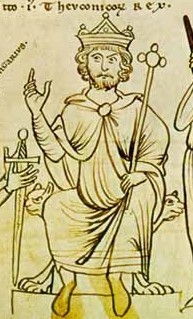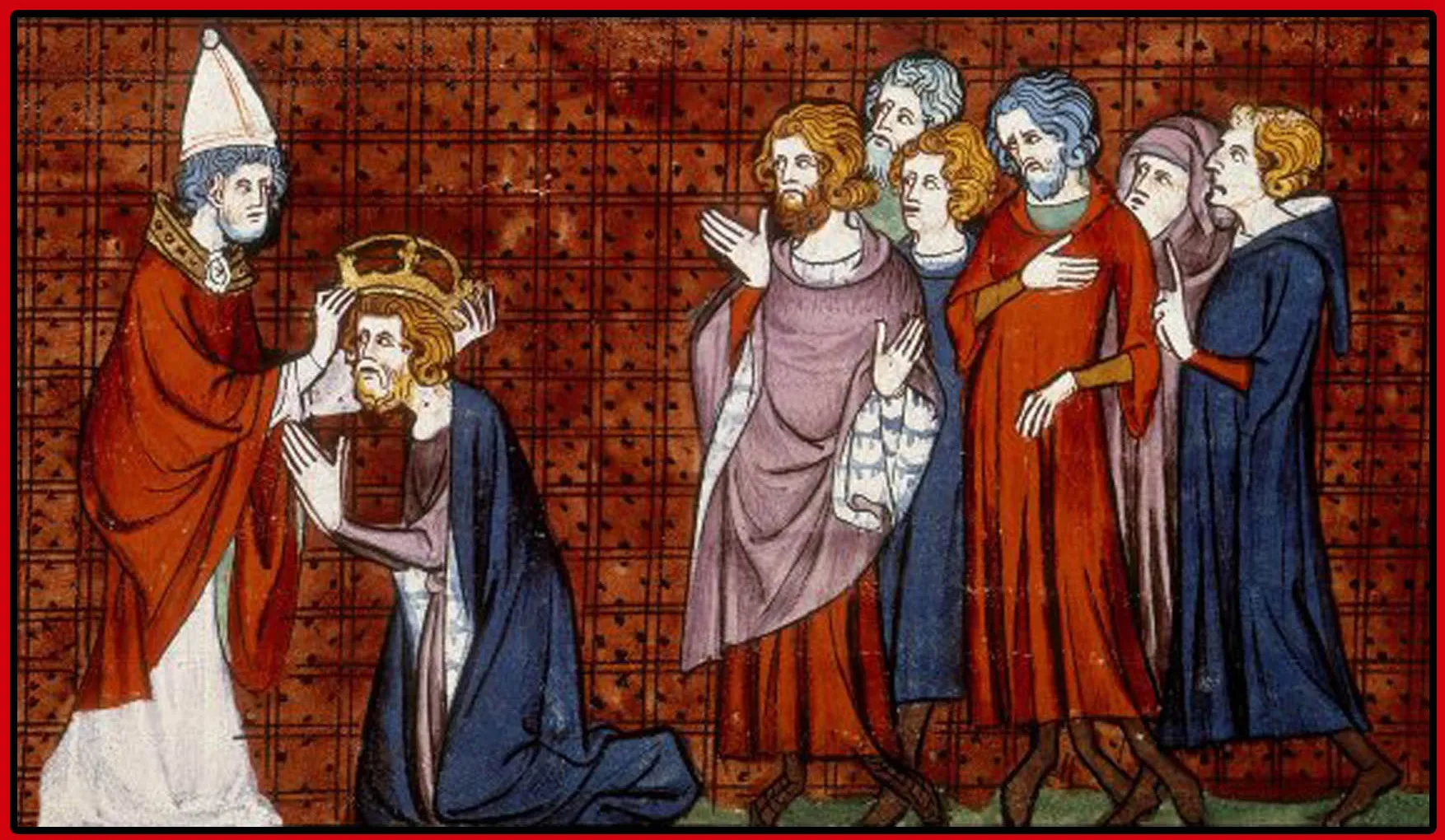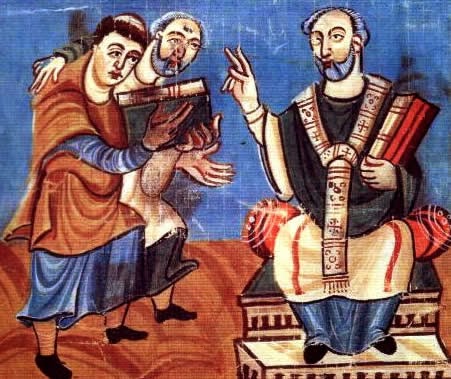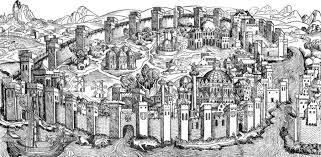During the 12th century, noble, monastic, and episcopal churches consolidated under papal leadership. Gradually, with the support of canonists tied to the papacy—who increasingly defined the legal identity and functions of the Church—the principle of the Church’s freedom and autonomy emerged, culminating in the papacy’s claim to leadership within the Church. It thus fell to the pope to resolve the Church’s affairs, though the Church could delegate their execution to temporal authorities. A significant turning point was the reform of Gregory VII (1073–1085), who, with his Dictatus Papae (1075), strongly promoted papal supremacy over imperial authority. This reached its zenith under Innocent III (1198–1216), when the balance shifted from imperial theocracy to papal hierocracy. However, the Church first needed to undertake an internal moral cleansing, addressing severe disorders—namely, Nicolaitism and Simony. Nicolaitism, Simony, and Theocratic Rule of Monarchs
By the mid-11th century, the Church—particularly its clergy—was plagued by Nicolaitism and Simony, two vices encouraged by the theocratic mindset of the sovereigns of the time. These problems arose from the Church’s excessive involvement in worldly affairs. Nicolaitism referred to an early heresy mentioned only in the Book of Revelation (Rev. 2:6, 15), of which little is known beyond its Gnostic and libertine tendencies. It also came to signify clerical concubinage, despite the obligation of celibacy imposed on clergy since the 6th century. Simony—derived from Simon Magus’s attempt to buy spiritual gifts (Acts 8:18–24)—referred to the buying, selling, or commercialization of sacred offices and goods. Gregory the Great (590–604) identified three forms: munus a manu (bribes), munus a lingua (recommendations), and munus ab ossequio (services rendered). These corrupt practices degraded the Church’s moral standing and sparked protest movements from within. Among the bishops who opposed such corruption was Raterius of Verona (931–968). Reform necessitated the cultivation of a new moral conscience, sensitive to spiritual values. Closely related to simony was the theocratic system of rulers in the 11th century, whereby kings and lords claimed the right to appoint bishops, abbots, and other ecclesiastical positions linked to landed benefices. The issue of ecclesiastical investiture—asserted as a sovereign or lordly right—was rooted in the feudal system of the time. Churches, monasteries, and parishes built on private lands were considered the property of the landowner, who enjoyed their benefits and authority. Consequently, the appointment of bishops or other ecclesiastical offices required royal or feudal approval. Appointments entailed two acts: investiture, involving homage, and consecration. Over time, these acts became conflated, binding spiritual office to feudal allegiance. This structure reflected the feudal system, which combined benefices with vassalage—a bond of loyalty between vassal and lord. This state of affairs ended with the Gregorian Reform (Gregory VII, 1073–1085), which distinguished regalia (temporal rights) from spiritualia (spiritual rights)—the former belonging to the sovereign, the latter to the Church.

Henry III and the Synod of Sutri
Under Charlemagne and the German Ottonians, the Empire and Papacy coexisted as distinct yet complementary realities within the Ecclesia Universalis. With the young emperor Otto III emerged the idea of the Renovatio Imperii Romanorum in a Christian framework—envisioning a federation of equal, independent nations with Rome as its capital. This vision collapsed after Otto’s death and a popular uprising that expelled him from Rome. Meanwhile, the papacy fell into disrepute under a succession of simoniacal and scandalous popes. Henry III, inspired by high religious ideals and a commitment to reform, intervened to restore order. He reclaimed control of the Church hierarchy, imposing candidates of his choosing as popes. Henry III’s actions marked the triumph of the Imperium over the Sacerdotium but also reestablished order within the Church, freeing the papacy from the turmoil of Roman noble families. On December 20th, 1046, Henry III convened the Synod of Sutri, the pinnacle of imperial Church reform, deposing rival popes Sylvester III and Gregory VI. Three days later, at a second synod in Rome, he deposed Benedict IX and appointed Clement II. The groundwork was thus laid for the great Gregorian Reform, preceded by spiritual renewal radiating from the Abbey of Cluny, a monastery founded in 910 and directly subordinate to the pope, thus shielded from local powers. Cluny reinvigorated the Rule of St. Benedict, hosting 300 monks and overseeing nearly 2,000 dependent monasteries across Christendom. This spiritual ferment paved the way for Gregory VII’s monumental reform (1073–1085).
The Gregorian Reform
The Church’s excessive subjugation to the Empire deprived it of its true identity and hindered its mission. This spurred an internal movement for recovery, culminating in Gregory VII’s reform, aimed at restoring the Church’s spiritual identity through the affirmation of its autonomy: the Libertas Ecclesiae. The reform sought to moralize the clergy and spiritually renew the Church. Cardinal Humbert of Silva Candida provided a systematic critique, rejecting the systems of “proprietary churches” and “royal churches.” The Gregorian Reform addressed Nicolaitism, simony, and imperial theocracy, unfolding in four phases:
- First Phase (1046–1057): Initiated as a moral reform against Nicolaitism and simony, supported by Henry III. The Synod of Sutri (1046) began reorganizing the papacy, a prerequisite for broader Church reform. Notable among the German popes appointed was Leo IX (1049–1054), a zealous reformer.
- Second Phase (1057–1073): Reformers like Humbert of Silva Candida recognized the need to dismantle medieval institutions such as the sale of churches and investitures. The 1059 Roman Synod forbade lay investiture and established papal election by the College of Cardinals.
- Third Phase (1073–1085): Gregory VII implemented radical reforms, prohibiting lay investiture and articulating papal authority in his Dictatus Papae (1075), a series of 27 theses outlining the papacy’s new role. Conflict arose with Henry IV of Germany, leading to Henry’s excommunication (1076). Henry responded at the Synod of Worms (1076), declaring Gregory deposed. Left isolated, Henry undertook his penitential journey to Canossa (1077), where Gregory forgave him. Reconciliation was short-lived. Henry IV was excommunicated again in 1080, invaded Italy, deposed Gregory VII, and appointed Clement III as pope. Gregory died in exile in 1085.
- Fourth Phase (1085–1124): The conflict persisted until the Concordat of Worms (1122), a compromise between Pope Callixtus II and Emperor Henry V. The agreement granted free episcopal elections to the clergy, renounced lay investiture, and allowed the emperor to confer feudal authority via the scepter. This ended imperial theocracy and inaugurated papal hierocracy, prefigured in Gregory VII’s Dictatus Papae and culminating under Innocent III (1198–1216).
The Theological-Legal Basis of the Reform
The Church not only asserted its autonomy but grounded its claims theologically, portraying itself as God’s work on Earth, founded by Christ and entrusted to the clergy—not kings. Episcopal investiture was deemed an ecclesiastical act, and royal involvement was condemned as arrogant and disruptive to divine order. Synodality was revived, fostering internal reflection and self-governance. Simony and Nicolaitism were recognized as signs of the Church’s degradation and targeted for elimination.
The Pope Claims the Role of Leader
The Libertas Ecclesiae was inseparable from the Petrine-apostolic principle, affirming the papacy as the Church’s primary guide. This principle, rooted in scriptural rivalry between the patriarchates of Rome and Constantinople, was articulated by Pope Gelasius I, who distinguished the auctoritas sacrata pontificum from the potestas regalis. Documents such as the Pseudo-Isidorian Decretals and the Dictatus Papae (1075) provided foundational arguments for papal supremacy, solidifying the Church’s independence and dominance over temporal powers.


 Le Lezioni sulla filosofia della storia, tenute da Georg Wilhelm Friedrich Hegel nel 1821, 1824, 1827 e 1831 alla Humboldt-Universität zu Berlin, raccolte e pubblicate postume, nel 1837, da Eduard Gans e dal figlio Karl, esaminano la relazione tra l’evoluzione storica e il progresso del pensiero umano, secondo i principi della dialettica hegeliana. Hegel sostiene che la storia sia un processo razionale, guidato da una logica interna, che si sviluppa attraverso contraddizioni e sintesi successive, riflettendo il progresso dello spirito (Geist) verso la realizzazione di sé.
Le Lezioni sulla filosofia della storia, tenute da Georg Wilhelm Friedrich Hegel nel 1821, 1824, 1827 e 1831 alla Humboldt-Universität zu Berlin, raccolte e pubblicate postume, nel 1837, da Eduard Gans e dal figlio Karl, esaminano la relazione tra l’evoluzione storica e il progresso del pensiero umano, secondo i principi della dialettica hegeliana. Hegel sostiene che la storia sia un processo razionale, guidato da una logica interna, che si sviluppa attraverso contraddizioni e sintesi successive, riflettendo il progresso dello spirito (Geist) verso la realizzazione di sé. In domestic politics, Otto I diminished the power of dukes and counts by granting public rights to bishops and abbots. He reserved the right to appoint bishops, making them pillars upon which the Kingdom of Germany rested. In foreign affairs, Otto I descended into Italy in 951 to free Adelaide from Berengar II and marry her. During this campaign, he assumed the title of King of Italy in Pavia. Subsequently, Pope John XII (955–963) sought Otto’s help against Berengar II. In 962, Otto was crowned emperor and recognized as such. On this occasion, he granted the papacy the “Privilegium Ottonianum,” reaffirming the ecclesiastical privileges from Charlemagne’s era and requiring newly elected popes to swear loyalty to the Emperor. However, John XII’s intrigues led Otto to limit papal autonomy, decreeing that no pope could be elected without his consent. John XII was deposed, and Leo VIII was elected in his place. While the papacy lost its autonomy under Otto I, this reform rescued it from the dark crisis of the “Saeculum Obscurum” (the Dark Age).
In domestic politics, Otto I diminished the power of dukes and counts by granting public rights to bishops and abbots. He reserved the right to appoint bishops, making them pillars upon which the Kingdom of Germany rested. In foreign affairs, Otto I descended into Italy in 951 to free Adelaide from Berengar II and marry her. During this campaign, he assumed the title of King of Italy in Pavia. Subsequently, Pope John XII (955–963) sought Otto’s help against Berengar II. In 962, Otto was crowned emperor and recognized as such. On this occasion, he granted the papacy the “Privilegium Ottonianum,” reaffirming the ecclesiastical privileges from Charlemagne’s era and requiring newly elected popes to swear loyalty to the Emperor. However, John XII’s intrigues led Otto to limit papal autonomy, decreeing that no pope could be elected without his consent. John XII was deposed, and Leo VIII was elected in his place. While the papacy lost its autonomy under Otto I, this reform rescued it from the dark crisis of the “Saeculum Obscurum” (the Dark Age).



 Missionary Activity
Missionary Activity Anglo-Saxon Missions
Anglo-Saxon Missions
